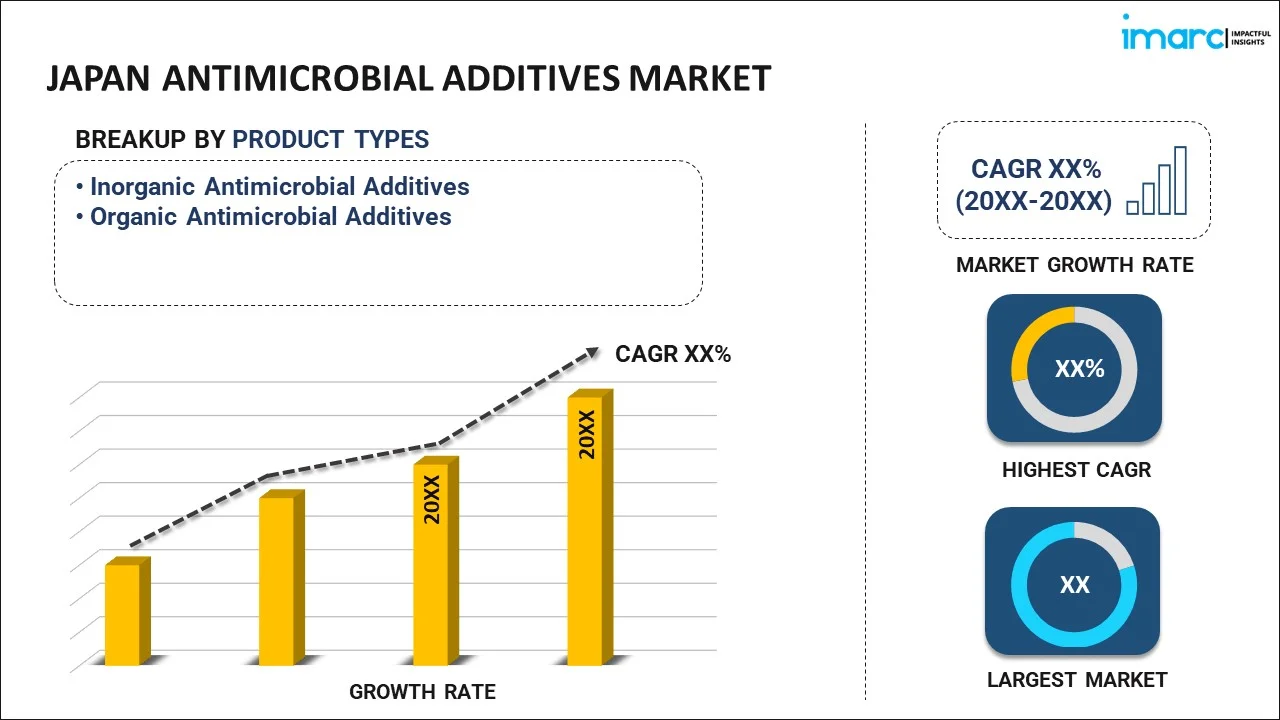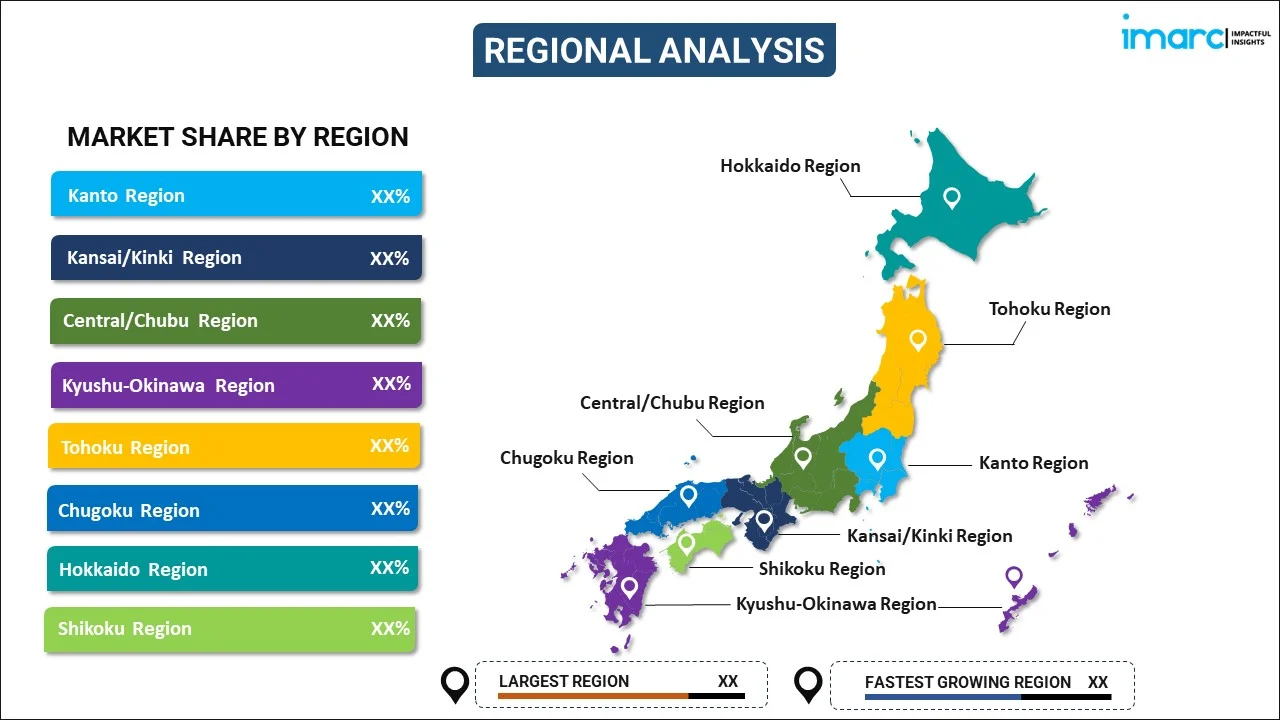
Japan Antimicrobial Additives Market Report by Product Type (Inorganic Antimicrobial Additives, Organic Antimicrobial Additives), Application (Plastic, Paints and Coatings, Pulp and Paper, and Others), End User (Construction, Automotive, Healthcare, Food and Beverage, and Others), and Region 2025-2033
Market Overview:
The Japan antimicrobial additives market size reached USD 283.5 Million in 2024. Looking forward, IMARC Group expects the market to reach USD 469.0 Million by 2033, exhibiting a growth rate (CAGR) of 5.32% during 2025-2033. The rising concerns about hygiene and infection control in healthcare settings, the growing product demand in the food and beverage (F&B) industry, the implementation of various government initiatives, and the increasing prevalence of natural disasters like earthquakes in Japan represent some of the key factors driving the market.
|
Report Attribute
|
Key Statistics
|
|---|---|
|
Base Year
|
2024
|
|
Forecast Years
|
2025-2033
|
|
Historical Years
|
2019-2024
|
| Market Size in 2024 | USD 283.5 Million |
| Market Forecast in 2033 | USD 469.0 Million |
| Market Growth Rate 2025-2033 | 5.32% |
Antimicrobial additives are specialized chemical agents that are designed to be integrated into various types of materials with the aim of inhibiting or eliminating the growth of microorganisms, such as fungi, mold, and bacteria. They can be broadly categorized into organic and inorganic types, each with unique attributes. Antimicrobial additives exhibit distinct properties, like high thermal stability, excellent dispersion capabilities, and sustained antimicrobial efficacy over time. They find applications in various sectors, including healthcare, food and beverages (F&B), textiles, consumer goods, agriculture, water treatment, construction, and automotive industries. Antimicrobial additives aid in extending product life, improving public health, and lowering costs in maintenance and care. Moreover, they offer enhanced durability, improved hygiene, reduced microbial contamination, and increased consumer trust.
Japan Antimicrobial Additives Market Trends:
The rising concerns about hygiene and infection control in healthcare settings, leading to increased usage of antimicrobial additives in medical devices, hospital furnishings, and other healthcare-related products, are creating a positive outlook for the market growth. In addition to this, the rising demand for antimicrobial additives in the food and beverage (F&B) industry to extend the shelf life of perishable items, thereby reducing food waste and enhancing safety, is bolstering the market growth. Along with this, the increasing awareness among consumers regarding foodborne illnesses, boosting product adoption, is favoring the market growth. Besides this, the escalating product demand in the construction sector for paints, concrete, and other building materials to improve longevity and reduce maintenance costs is positively influencing the market growth. The market is also being driven by the implementation of various government initiatives focusing on sustainable construction. Furthermore, the increasing prevalence of natural disasters like earthquakes in Japan, requiring building materials that are strong and hygienic to prevent the outbreak of diseases in the aftermath, is providing an impetus to the market growth. Apart from this, the heightened utilization of antimicrobial additives in the automotive sector for car interiors, air conditioning systems, and electronic devices to enhance durability and user experience is fostering the market growth. Moreover, the widespread product demand in personal care products, toys, and home appliances for added functionality and safety is strengthening the market growth. Along with this, the integration of advanced antimicrobial agents into various materials without affecting their mechanical properties and the adoption of nanotechnology to create effective product solutions are favoring the market growth. In addition to this, the increasing international trade activities and globalization, leading to stringent regulations and standards for product safety and quality, are fueling the market growth.
Japan Antimicrobial Additives Market Segmentation:
IMARC Group provides an analysis of the key trends in each segment of the market, along with forecasts at the country level for 2025-2033. Our report has categorized the market based on product type, application, and end user.
Product Type Insights:

- Inorganic Antimicrobial Additives
- Organic Antimicrobial Additives
The report has provided a detailed breakup and analysis of the market based on the product type. This includes inorganic antimicrobial additives and organic antimicrobial additives.
Application Insights:
- Plastic
- Paints and Coatings
- Pulp and Paper
- Others
A detailed breakup and analysis of the market based on the application have also been provided in the report. This includes plastic, paints and coatings, pulp and paper, and others.
End User Insights:
- Construction
- Automotive
- Healthcare
- Food and Beverage
- Others
The report has provided a detailed breakup and analysis of the market based on the end user. This includes construction, automotive, healthcare, food and beverage, and others.
Regional Insights:

- Kanto Region
- Kansai/Kinki Region
- Central/ Chubu Region
- Kyushu-Okinawa Region
- Tohoku Region
- Chugoku Region
- Hokkaido Region
- Shikoku Region
The report has also provided a comprehensive analysis of all the major regional markets, which include Kanto Region, Kansai/Kinki Region, Central/ Chubu Region, Kyushu-Okinawa Region, Tohoku Region, Chugoku Region, Hokkaido Region, and Shikoku Region.
Competitive Landscape:
The market research report has also provided a comprehensive analysis of the competitive landscape in the market. Competitive analysis such as market structure, key player positioning, top winning strategies, competitive dashboard, and company evaluation quadrant has been covered in the report. Also, detailed profiles of all major companies have been provided.
Japan Antimicrobial Additives Market Report Coverage:
| Report Features | Details |
|---|---|
| Base Year of the Analysis | 2024 |
| Historical Period | 2019-2024 |
| Forecast Period | 2025-2033 |
| Units | Million USD |
| Scope of the Report | Exploration of Historical and Forecast Trends, Industry Catalysts and Challenges, Segment-Wise Historical and Predictive Market Assessment:
|
| Product Types Covered | Inorganic Antimicrobial Additives, Organic Antimicrobial Additives |
| Applications Covered | Plastic, Paints and Coatings, Pulp and Paper, Others |
| End Users Covered | Construction, Automotive, Healthcare, Food and Beverage, Others |
| Regions Covered | Kanto Region, Kansai/Kinki Region, Central/ Chubu Region, Kyushu-Okinawa Region, Tohoku Region, Chugoku Region, Hokkaido Region, Shikoku Region |
| Customization Scope | 10% Free Customization |
| Post-Sale Analyst Support | 10-12 Weeks |
| Delivery Format | PDF and Excel through Email (We can also provide the editable version of the report in PPT/Word format on special request) |
Key Questions Answered in This Report:
- How has the Japan antimicrobial additives market performed so far and how will it perform in the coming years?
- What has been the impact of COVID-19 on the Japan antimicrobial additives market?
- What is the breakup of the Japan antimicrobial additives market on the basis of product type?
- What is the breakup of the Japan antimicrobial additives market on the basis of application?
- What is the breakup of the Japan antimicrobial additives market on the basis of end user?
- What are the various stages in the value chain of the Japan antimicrobial additives market?
- What are the key driving factors and challenges in the Japan antimicrobial additives?
- What is the structure of the Japan antimicrobial additives market and who are the key players?
- What is the degree of competition in the Japan antimicrobial additives market?
Key Benefits for Stakeholders:
- IMARC’s industry report offers a comprehensive quantitative analysis of various market segments, historical and current market trends, market forecasts, and dynamics of the Japan antimicrobial additives market from 2019-2033.
- The research report provides the latest information on the market drivers, challenges, and opportunities in the Japan antimicrobial additives market.
- Porter's five forces analysis assist stakeholders in assessing the impact of new entrants, competitive rivalry, supplier power, buyer power, and the threat of substitution. It helps stakeholders to analyze the level of competition within the Japan antimicrobial additives industry and its attractiveness.
- Competitive landscape allows stakeholders to understand their competitive environment and provides an insight into the current positions of key players in the market.
Need more help?
- Speak to our experienced analysts for insights on the current market scenarios.
- Include additional segments and countries to customize the report as per your requirement.
- Gain an unparalleled competitive advantage in your domain by understanding how to utilize the report and positively impacting your operations and revenue.
- For further assistance, please connect with our analysts.
 Inquire Before Buying
Inquire Before Buying
 Speak to an Analyst
Speak to an Analyst
 Request Brochure
Request Brochure
 Request Customization
Request Customization




.webp)




.webp)












